植物物候常被认为是反映气候与环境变化的重要指标[1- 2],也被视为全球气候变化的“诊断指纹”[3]。苹果始花期是表征苹果果实开始生长的重要指示物候期[4],直接影响到苹果品质和产量的形成[5-6]。因而,开展苹果花期与气象条件的关系及其对气候变化响应的研究,以及花期预测,对指导当地苹果生产具有十分重要的意义。
Chmielewski 等[7]、Grab 等[8]分别发现德国和南非的苹果开花期平均每10 a(年)提前2.1 d和4.3 d,Mariko等[9]也指出1980—2010年日本长野的苹果开花期提前6.3 d,这些主要与春季气温的升高有关。刘璐等[10-11]研究发现,中国北方主产地苹果始花期以2.3 d·10 a-1的速率提前,并与时段内平均气温和平均地温存在显著的负相关关系。在苹果花期预报方法方面,国内学者做了大量研究工作[11-17],方法各异,邬定荣等[12]采用机制性物候模型预测苹果花期;冯建设等[13]采用逐步回归方法,建立具有生物学意义的动态预报模型;李美荣等[14]应用统计学方法建立基于平均气温和日照时数的苹果始花期预测模型;张兴伟等[15]采用多元线性回归方法和组合方法,建立山西省吉县苹果果树始花期的预测模型。但大部分学者采用不同时间尺度(日、旬和月)气候要素与始花期之间建立统计回归模型,虽然未考虑苹果树的生理生态过程,但该方法简单易行,能较准确地预测苹果花期。
受苹果物候期观测数据较少的限制,西藏苹果物候期研究鲜见报道,尤其花期预测更是空白。为此笔者在本研究中选取西藏最适宜的栽培区——林芝的苹果长期连续物候期观测和气象数据,采用Pearson相关系数、逐步回归等方法,分析旬和月日照、温度、降水量等气候因子对苹果花期的影响,判定影响花期的主要气候因子,在此基础上构建花期预测模型,同时还分析了花期晚霜冻的变化特征,以期为科学有效开展西藏苹果花期气象服务提供科技支撑。
1 数据来源和研究方法
1.1 研究区概况
西藏自治区林芝市巴宜区(E 93°27′~95°17′,N 29°21′~30°15′)地处青藏高原念青唐古拉山东南麓,位于西藏东南部,属高原温带季风半湿润气候。年太阳总辐射4 224.2 MJ·m-2,年日照时数2 022.0 h;年平均气温9.1 ℃,气温年较差15.1 ℃,年极端最高气温30.6 ℃,年极端最低气温-13.7 ℃,≥0 ℃积温3 319.9 ℃·d·a-1;年降水量692.7 mm,年平均相对湿度64%,年无霜期173 d。
苹果是西藏主要经济林果之一,在自治区果业生产中占有举足轻重的地位。西藏林芝为苹果的主要栽培区,不仅苹果产量高,而且色、香、味俱佳,是西藏最适宜的苹果栽培区[18]。2020年全自治区苹果种植面积为1670 hm2,总产量达7959 t[19],其中林芝市苹果种植面积为557 hm2,总产量为4506 t,分别占全自治区种植面积和总产量的33.4%和56.6%。
1.2 数据来源和处理
苹果花期物候资料来源于西藏自治区林芝农业气象观测站,观测依据和标准按照中国气象局《农业气象观测规范》[20]。选取2001—2021 年林芝苹果花芽膨大期、花芽开放期、始花期、盛花期和末花期。花期长度为始花期与末花期之间的天数。
气象要素来源于西藏自治区气象信息网络中心,选取同时段的逐日平均气温(Tm,℃)、最高气温(Tmax,℃)、最低气温(Tmin,℃)、气温日较差(DTR,℃)、相对湿度(RH,%)、降水量(Pr,mm)、日照时数(S,h)和逐旬平均5 cm地温(Tg5,℃)、10 cm地温(Tg10,℃)和20 cm地温(Tg20,℃)等数据。
1.3 方法
苹果花期及长度、气象要素的变化趋势均利用线性倾向估计法,并采用F 检验法对其显著性进行检验(p<0.05和p<0.01)。
花期霜冻:以百叶箱内日最低气温≤0 ℃为霜冻指标,分析花期晚霜冻的变化特征。
利用Pearson 相关系数分析各气象要素与花期及长度的相关性,并采用逐步回归方法[21]建立花期的预测模型。

数据处理和绘图均采用Excel 2007 软件完成,并利用DPS数据处理系统[22]提供的逐步回归方法建立预测模型。
2 结果与分析
2.1 花期及生育期长度的变化趋势
从近21 年(2001—2021 年)西藏林芝苹果花期及生育期长度的变化趋势来看(表1),苹果各花期均呈显著的推迟趋势,平均每年推迟0.884~1.132 d(p<0.05),以花芽膨大期推迟的最多(p<0.01),其次是始花期,为1.058 d(p<0.01),末花期推迟的最少。花期长度表现为显著的缩短趋势,平均每年缩短0.471 d(图1,p<0.05)。

图1 2001—2021 年西藏林芝苹果花期长度(a)和开花始期(b)的变化
Fig.1 Change of apple's FD(a)and IFD(b)in Nyingchi of Tibet from 2001 to 2021
表1 2001—2021 年西藏林芝苹果花期变化趋势
Table 1 Linear trend of apple flowering phase in Nyingchi of Tibet from 2001 to 2021
注:FED、FOD、IFD、FBD、TFD、FD 分别表示花芽膨大期、花芽开放期、开花始期、开花盛期、开花末期和花期长度;*,**分别表示p<0.05,p<0.01。下同。
Note:FED.Flower bud enlargement date;FOD.Flower bud opening date;IFD.Initial flowering date;FBD.Full bloom date;TFD.Terminal flowering date;FD.Flowering duration.*,**indicate significant difference at p<0.05,p<0.01 respectively.The same below.
花期Flowering phase变化趋势Linear trend/(d·a-1)花期长度FD-0.471*花芽膨大期FED 1.132**花芽开放期FOD 0.884*开花始期IFD 1.058**开花盛期FBD 1.017**开花末期TFD 0.529*
2.2 花期间气候要素的变化趋势
表2给出了2001—2021年苹果各花期间气候要素的线性变化趋势,结果显示:(1)除开花盛期—开花末期的Tmax呈降低趋势外,其他花期Tm、Tmax、Tmin均趋于升高,升温率为0.050~0.125 ℃·a-1,其中Tmin升幅大于Tmax升幅;期间的DTR都呈现出减小趋势,为0.024~0.125 ℃·a-1,S 也表现为减少趋势,减幅为0.099~3.495 h·a-1,以开花盛期—末期减少的最多,达3.495 h·a-1(p<0.01)。(2)RH 在花芽膨大期—花芽开放期上倾向于增加,在其他花期间均趋于减少,平均每年减少0.014%~0.153%,以花芽开放期—开花始期减幅最为明显。(3)始花期之前,Pr为增加趋势,增幅为0.045~0.131 mm·a-1;之后Pr趋于减少,平均每年减少0.094~0.627 mm。(4)≥0 ℃积温(∑T0)在4 个花期物候生长期中增减趋势各占一半,其中在花芽开放期—始花期、始花期—盛花期为增加趋势;盛花期—末花期∑T0 减少趋势尤为明显,达4.695 ℃·d·a-(1p<0.05)。(5)在花期生长期内,只有Tm、Tmin表现为上升趋势,其他要素均趋于下降,其中∑T0减幅达3.748 ℃·d-1·a-1。
表2 2001—2021 年西藏林芝苹果花期间气候要素的变化趋势
Table 2 Linear trend of climatic elements at apple flowering phase in Nyingchi of Tibet from 2001 to 2021
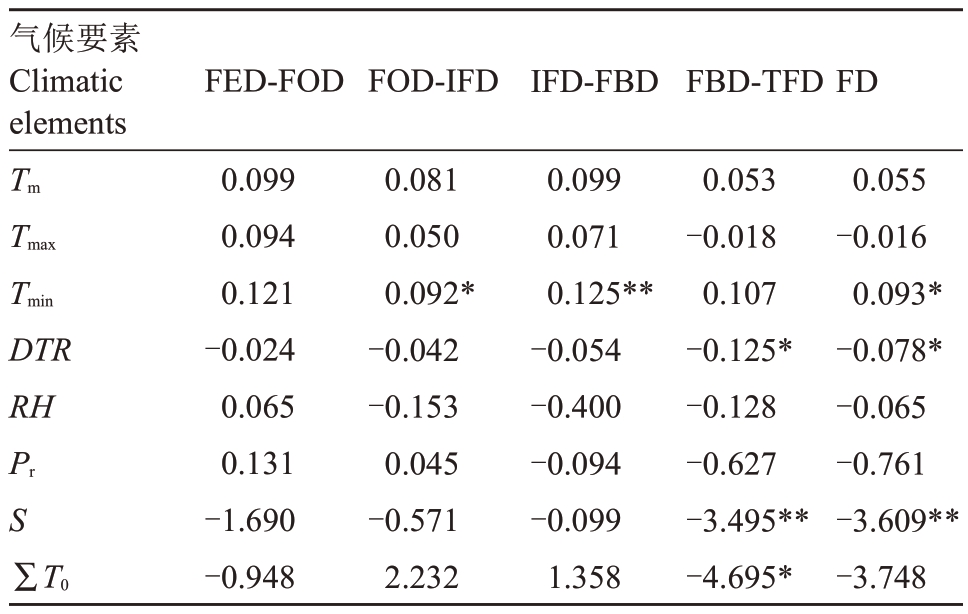
注:Tm.平均气温;Tmax.最高气温;Tmin.最低气温;DTR. 气温日较差;RH.相对湿度;Pr.降水量;S.日照时数;∑T0.≥0 ℃积温;下同.
Note:Tm.mean temperature;Tmax.maximum temperature;Tmin.minimum temperature; DTR. diurnal temperature range; RH. relative humidity; Pr. precipitation; S. sunshine duration; ∑T0. accumulated temperature ≥0 ℃.The same below.
气候要素Climatic elements Tm Tmax Tmin DTR RH Pr S∑T0 FED-FOD 0.099 0.094 0.121-0.024 0.065 0.131-1.690-0.948 FOD-IFD 0.081 0.050 0.092*-0.042-0.153 0.045-0.571 2.232 IFD-FBD 0.099 0.071 0.125**-0.054-0.400-0.094-0.099 1.358 FBD-TFDFD 0.053-0.018 0.107-0.125*-0.128-0.627-3.495**-4.695*0.055-0.016 0.093*-0.078*-0.065-0.761-3.609**-3.748
此外,还发现近21 a花期长度生长期内的RH、S和∑T0波动较大,表现为3次曲线变化趋势,如图2-a所示,RH 总体呈现为“降-升-降”的变化趋势,在2001—2006 年、2006—2017 年、2017—2021 年3 个阶段的变幅分别为-1.12%·a-1、1.42%·a-1(p<0.01)和-4.25%·a-1。而S和∑T0则表现为“升-降-升”的变化趋势(图2-b、2-c),S 在2001—2006 年、2006—2017 年、2017—2021 年3 个阶段的变幅依次为21.66、-11.14、7.98 h·a-1,其中前2 个时段p<0.05;∑T0在2001—2006 年、2006—2017 年和2017—2021年3个时段分别以35.78、-17.25、17.20 ℃·d·a-1的速度变化,其中前2个时段p<0.05。Pr表现出先升后降的二次曲线变化(图2-d),其中前10年呈增加趋势,为2.91 mm·a-1,后11年以-1.53 mm·a-1的速度趋于减少。
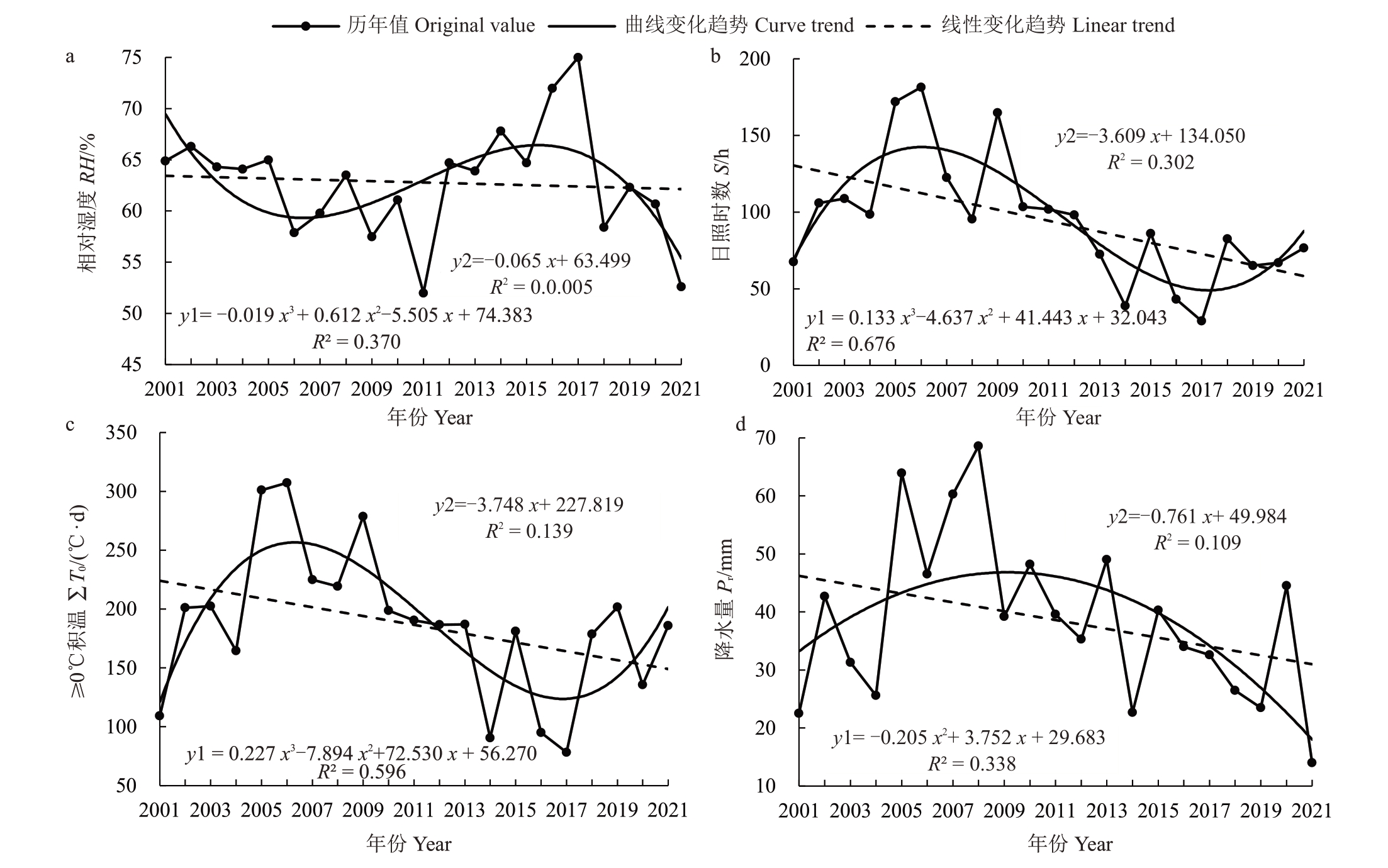
图2 2001—2021 年西藏林芝苹果花期长度生长期内的气候要素变化
Fig.2 Change of climatic elements at apple's FD in Nyingchi of Tibet from 2001 to 2021
2.3 花期物候与气候因子的关系
2.3.1 花期物候与旬尺度气候因子的关系 首先采用Pearson 相关系数分析了上年10 月上旬至当年4月下旬各旬气候要素与西藏林芝苹果花期物候的相关性,从通过p<0.05 显著性检验的气候因子中(表3),再利用逐步回归方法求得的标准回归系数,选取绝对值最大者作为主导气候因子,结果发现:(1)影响花芽膨大期早晚的气候因子较多,上年10月上旬Tmax,10月中旬Tmin,10月下旬Tg5、Tg10、Tg20,以及12月上中旬Tg5、Tg10、Tg20与其呈显著正相关,而与上年10 月上旬Pr、当年3 月上中旬S 呈显著负相关。这说明上年10 月和12 月的气温与地温越高,10 月上旬降水偏少,当年3月上中旬日照充足,苹果花芽膨大期就越早。经分析,3 月上旬S 是主导因子,如图3-a所示,若3月上旬S每增加(减少)10 h,花芽膨大期将提前(推迟)6.50 d。(2)同样影响花芽开放期的气候因子也较多,只有上年10 月下旬Tg5、Tg10、Tg20与其呈显著正相关;其他因子呈显著负相关,以10 月上旬Pr 的负相关系数最大,为-0.570(p<0.01)。其中,3 月上旬Tg5 是主导因子,从图3-b 可知,若当年3 月上旬Tg5 每升高(降低)1 ℃,花芽开放期将提前(推迟)4.28 d。(3)气候因子与始花期、盛花期的关系都是显著的负相关,表明上年10月上旬Pr越少、RH越小,来年苹果始花期和盛花期也越早;同样当年3月上中旬Tmax、S和Tg越高,苹果开花始期和盛期越早。分析得知,10月上旬Pr是始花期和盛花期的主导气候因子,若上年10 月上旬Pr每增加(减少)10 mm,苹果始花期、盛花期将分别提前(推迟)3.10 d(图3-c)和3.11 d(图3-d)。(4)影响开花末期变化的气候因子有3 月中旬Tg20、4 月中旬Tmin、4月上旬RH 和5 月上旬S,其中4 月中旬Tmin为正相关,其他气候因子为负相关,且3月中旬Tg20是主导因子,若当年3月上旬Tg20每升高(降低)1 ℃,末花期将提前(推迟)3.37 d(图3-e)。
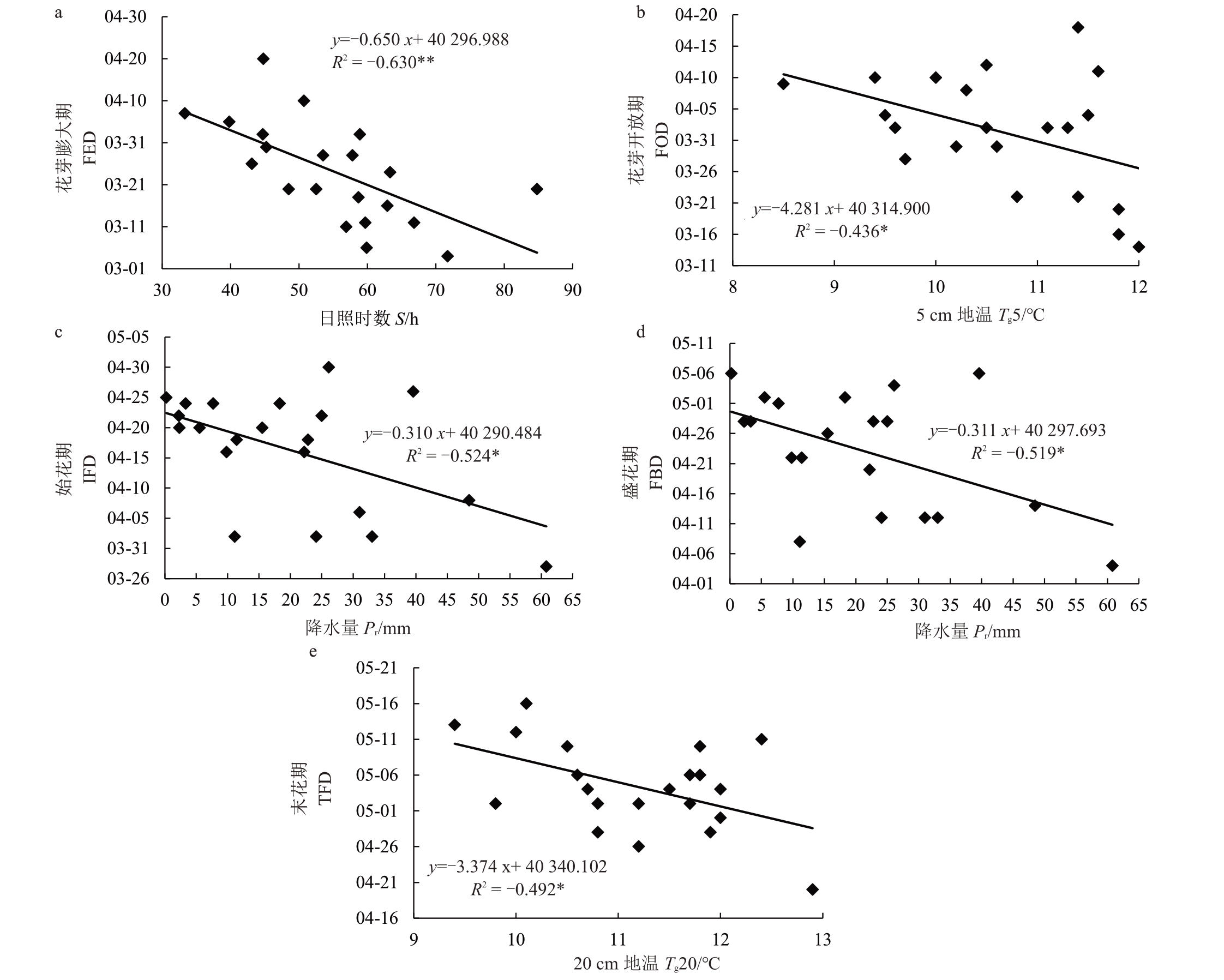
图3 2001—2021 年西藏林芝苹果花期与主导旬气候因子的点聚图
Fig.3 The relationship between major climatic factors of ten days and the apple flowering phase in Nyingchi of Tibet from 2001 to 2021
表3 西藏林芝苹果花期物候的旬气候影响因子
Table 3 Climatic factors every ten days affecting the apple flowering phase in Nyingchi of Tibet

注:气候因子下标数字:前2 位为月份,最后1 位为旬序,1、2、3 分别表示上旬、中旬和下旬。“+”“-”分别表示正相关和负相关。
Note:Subscript numbers of climate factor,the first 2 digits numbers indicates the month,the last number indicate the ten-day order,which that 1,2,3 indicate the first,middle and last respectively.“+”,“-”indicate positive and negative correlations,respectively.
花期Flowering phase FED FOD IFD FBD TFD通过p<0.05显著性检验的气候因子Climate factors passing significance test of p<0.05+Tmax101、+Tmin102、-Pr101、-S031、-S032、+Tg5103、+Tg5121、+Tg5122、+Tg10103、+Tg10121、+Tg10122、+Tg20103、+Tg20121、+Tg20122-Tmax122、-Tmax031、-Pr101、-Pr103、-S122、-S031、-S032、-RH101、-RH103、-RH023、+Tg5103、-Tg5031、+Tg10103、-Tg10031、+Tg20103-Tmax031、-Tmax032、-Pr101、-S031、-S032、-Tg5031、-Tg10031、-Tg20031、-Tg20032-Tmax031、-Pr101、-Pr031、-S032、-RH101、-RH023、-Tg5031、-Tg10031、-Tg20031、-Tg20032+Tmin042、-S051、-RH041、-Tg20032主导旬气候因子及相关系数R Dominant climate factors in ten days and correlation coefficients R S031,R=-0.630**Tg5031,R=-0.436*Pr101,R=-0.524*Pr101,R=-0.519*Tg20032,R=-0.492*
2.3.2 花期物候与月气候因子的关系 同理分析了上年10 月至当年4 月影响苹果花期物候的主导气候因子,结果(表4)显示:(1)影响花芽膨大期早晚的主导气候因子是3月S,两者相关系数为-0.578(p<0.01)。经分析,若3月S每增加(减少)10 h,花芽膨大期将提前(推迟)3.17 d。(2)上年10 月Pr是影响花芽开放期、开花始期和开花盛期的主导气候因子,其中Pr与花芽开放期的相关性达到极显著水平(p<0.01)。统计发现,若上年10 月Pr每增加(减少)10 mm,当年苹果花芽开放期、始花期和盛花期将分别提前(推迟)2.91 d、2.47 d 和2.17 d。(3)影响开花末期变化的主导因子为3 月Tg10,两者相关系数为-0.476(p<0.05)。经计算分析,若当年3 月Tg10 每升高(降低)1 ℃,开花末期将提前(推迟)4.28 d。
表4 影响西藏林芝苹果花期的月气候因子
Table 4 Monthly climatic factors affecting the apple flowering phase in Nyingchi of Tibet
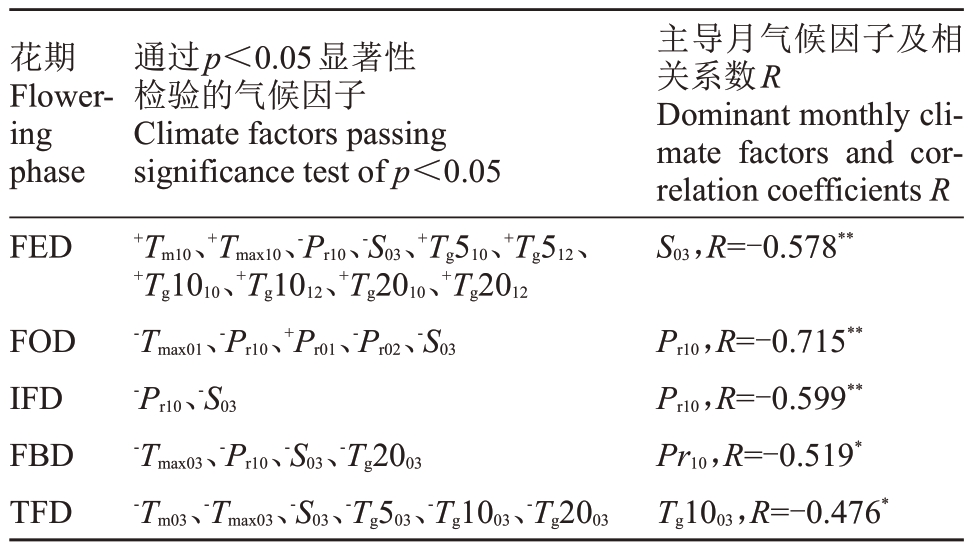
注:气候因子下标数字为月份;“+”“-”分别表示正相关和负相关。
Note:Climate factor subscript numbers are the month;“+”,“-”indicate positive and negative correlations,respectively.
花期Flowering phase FED FOD IFD FBD TFD通过p<0.05显著性检验的气候因子Climate factors passing significance test of p<0.05+Tm10、+Tmax10、-Pr10、-S03、+Tg510、+Tg512、+Tg1010、+Tg1012、+Tg2010、+Tg2012-Tmax01、-Pr10、+Pr01、-Pr02、-S03-Pr10、-S03-Tmax03、-Pr10、-S03、-Tg2003-Tm03、-Tmax03、-S03、-Tg503、-Tg1003、-Tg2003主导月气候因子及相关系数R Dominant monthly climate factors and correlation coefficients R S03,R=-0.578**Pr10,R=-0.715**Pr10,R=-0.599**Pr10,R=-0.519*Tg1003,R=-0.476*
2.4 花期生长期长度与气候因子的关系
从西藏东南部苹果花期生长期长度与同期气候要素的相关系数(表5)来看,各花期生长期长度与Tmin的相关性不显著;与S、≥0 ℃积温(∑T0)呈极显著的正相关,相关系数大于0.820(p<0.01);除花芽开放期—开花始期外,花期生长期长度与Pr存在显著的正相关,特别是盛花期—末花期长度,两者相关性达到极显著水平(p<0.01)。只有个别花期生长期长度与Tm、Tmax、DTR 和RH 存在显著的相关性,如花芽膨大期—花芽开放期长度与Tm、Tmax呈显著的负相关;花期长度与DTR 存在较显著的正相关;RH与花芽开放期—始花期长度、始花期—盛花期长度,以及花期长度有着显著的负相关关系。同理分析了影响各花期生长期长度变化的主导气候因子都是∑T0。
表5 2001—2021 年西藏林芝苹果花期生育期长度与气象要素的相关系数
Table 5 Correlation coefficients between the length of apple flowering phase and climatic elements in Nyingchi of Tibet from 2001 to 2021
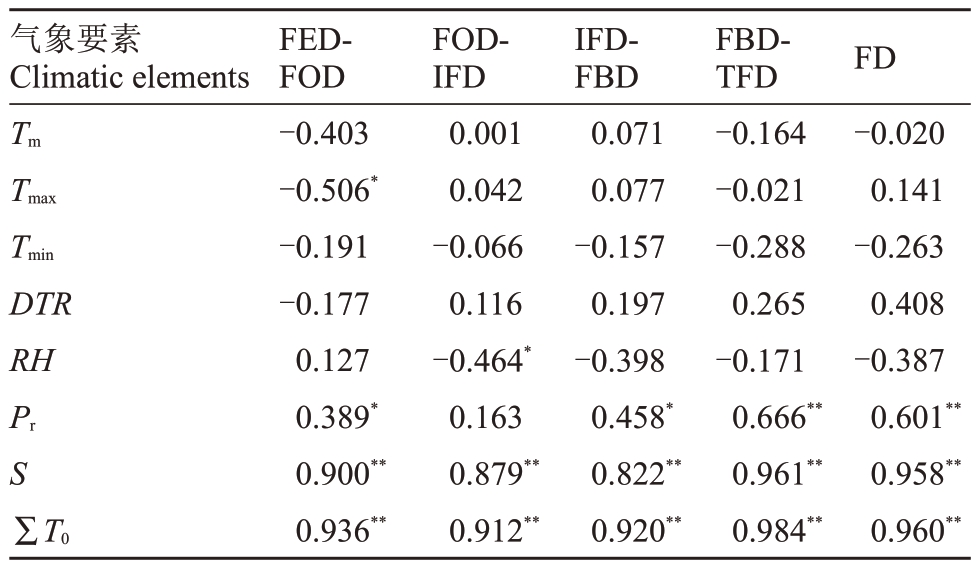
气象要素Climatic elements Tm Tmax Tmin DTR RH Pr S∑T0 FEDFOD-0.403-0.506*-0.191-0.177 0.127 0.389*0.900**0.936**FODIFD 0.001 0.042-0.066 0.116-0.464*0.163 0.879**0.912**IFDFBD 0.071 0.077-0.157 0.197-0.398 0.458*0.822**0.920**FBDTFD-0.164-0.021-0.288 0.265-0.171 0.666**0.961**0.984**FD-0.020 0.141-0.263 0.408-0.387 0.601**0.958**0.960**
2.5 霜冻对花期的影响
苹果花期内不同程度的低温会对苹果生长发育产生不同的影响[23-24]。以日最低气温≤0 ℃为霜冻指标,分析花期晚霜冻日及其最低气温的变化特征。经统计分析发现(表6),近21 a 林芝苹果开花始期晚霜冻发生的概率为33.3%,平均约每3 a 一遇;开花盛期出现晚霜冻的概率为19.0%,平均约5 a 一遇;而开花末期晚霜冻发生概率为0,从未遭遇晚霜冻的危害。
表6 2001—2021 年西藏林芝苹果花期晚霜冻发生概率
Table 6 Probability of late frosts for apple flowering phase in Nyingchi of Tibet from 2001 to 2021

花期Flowering phase频次Frequency概率Probability/%IFD 7.0 33.3 FBD 4.0 19.0 TFD 00
从林芝苹果花期晚霜冻的变化趋势来看(图4-a),近21 a 晚霜冻日呈提前趋势,平均每年提前0.594 d(未通过显著性检验水平)。其对应的日最低气温却趋于降低(图4-b),降幅为0.016 ℃·a-(1未通过显著性检验水平)。
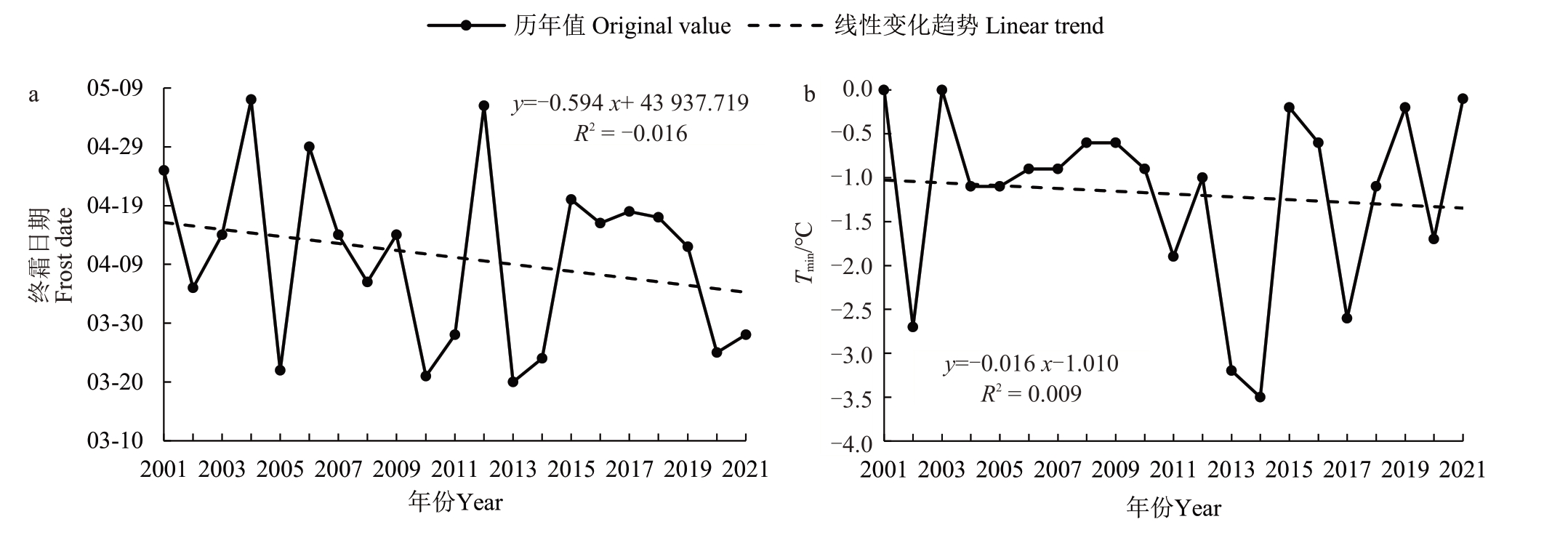
图4 2001—2021 年西藏林芝苹果花期晚霜冻日(a)和最低气温(b)的变化
Fig.4 Change of late frost date(a)and Tmin(b)for apple flowering phase in Nyingchi of Tibet from 2001 to 2021
以上分析表明,近21 a 林芝苹果花期遭遇晚霜冻的时间趋于提前,且其最低气温有降低的趋势,但开花期均呈显著的推迟趋势,这说明林芝苹果花期晚霜冻的气候风险可能变小。
2.6 花期预报模型
利用2001—2021年西藏林芝苹果花期(开花始期、盛期和末期)物候观测数据,以及表3和表4中影响苹果花期的主要气候因子,采用逐步回归方法,建立苹果花期统计回归预测模型(表7),预测模型均通过0.01显著性检验。并利用苹果花期实测值对模型进行精准度检验,发现21 a 预测平均精准度为95.8%~97.1%,以开花末期最高,说明预测模型的可信度高。
表7 西藏林芝苹果花期预测模型及检验结果
Table 7 The forecasting models of the apple flowering phase and their test result in Nyingchi of Tibet

注:DOY 为花期儒略日;气候因子表述同上。
Note:DOY is the ordinal day from Jan.1;The climatic factors are expressed as above.
花期Flowering phase开花始期IFD开花盛期FBD开花末期TFD预测模型Forecasting model DOYIFD=169.709-2.011Tmax031-0.176Pr101-0.0282Pr10-0.195S03 DOYFBD=288.481-0.859RH101-0.615RH023-4.110Tg20031-0.138S03 DOYTFD=165.899+2.099Tmin042-0.113S051-2.922Tg20032-0.0702S03 p值p value 0.003 8 0.000 2 0.005 1平均精准度Mean precision/%95.8 96.5 97.1
3 讨 论
林芝市巴宜区属高原温带季风半湿润气候,日照时数较长,辐射较强,热量水平高,雨热同季,农业气候资源较为丰富,是西藏最适宜的苹果栽培区[18]。由于西藏站点稀少,林芝市巴宜区的长时间序列观测资料只有林芝站,海拔高度2 991.8 m,其能够代表该区域海拔2800~3100 m河谷地带的气候特征,与其邻近的米林站也属于同一气候区,气候条件适宜苹果的生长发育,这里不仅苹果产量高,而且色、香、味俱佳。
全球气候变暖,气温升高增加了果树生长发育所需热量,进而影响果树生长进程,其中开花期提早就是气候变暖的重要标志。目前,欧洲、美国东北部及亚洲的大部均发现苹果开花期提前[7-9,25]。在中国新疆、黄土高原和渤海湾各苹果主产区,始花期均呈显著的提前趋势[26]。而本研究分析认为,西藏林芝苹果花期却表现为显著的推迟趋势,造成这种差异的主要原因可能是由于苹果正常开花需冬季低温能满足果树对低温需冷量的需求,同时春季升温又能满足果树开花对生物学积温的需求[27-28]。近60 a 西藏林芝升温明显,特别是冬季[29],造成苹果冬季低温需冷量不足,打破花芽休眠进程推迟,致使花期推迟。
温度作为影响果树物候期的主要气候因子是无可厚非的事实。已有的研究认为,在影响果树开花期的气候因子中,气温具有显著的负作用[5-7,30-31]。在地温方面研究较少,刘璐等[11]指出中国北方苹果主产地始花期与平均地温均呈显著负相关关系。本研究发现,只有个别苹果花期及生长期长度与平均气温存在显著的负相关,但苹果花期与旬平均地温(5、10和20 cm)具有显著的相关性,且在花期预测回归模型中地温的贡献大于气温。
除温度外,降水、相对湿度和日照时数亦是影响果树物候期的重要气候因子。多数研究成果认为降水对果树始花期无显著影响[11,32-33];张艳艳等[34]研究指出,影响陇东苹果开花早晚的主要影响因素是热量因子,日照次之,降水影响最小。本研究分析得到,降水量和相对湿度对苹果花期均具有显著影响,以负作用为主;日照时数与花期也呈现出显著的负相关,但日照对苹果花期的影响程度小于降水,这在影响的主导月气候因子中可得以证实。
根据林芝苹果花期与气象条件的关系,花期主要有霜冻、干旱、冰雹等农业气象灾害[35],其中以晚霜冻危害较大。做好霜冻的防御,一是在果树萌芽到开花前灌水1 次,可降低地温,推迟开花;二是早春用涂白剂刷枝干,以减少辐射吸收,推迟或延长萌芽开花;三是根据当地气象部门预报,若晴空晚上气温降到0 ℃时,可通过燃烧麦秸、杂草等使其发烟,既可增加环境温度,也可减少辐射降温,提高果园气温,防止晚霜冻对花期的影响。此外,可选育花期抗寒品种、开展不同苹果品种花期冻害调查并对不同层面的果树冻害机制的研究[36],为品种推广及防霜技术的研发提供理论支撑。
4 结 论
2001—2021 年西藏林芝苹果各花期以0.884~1.132 d·a-1的速度趋于推迟,以花芽膨大期推迟的最多;花期长度平均每年缩短0.471 d。大部分花期生长期内Tm、Tmax、Tmin均趋于升高,DTR、S、RH 趋于减少;始花期之前,Pr为增加趋势,之后Pr趋于减少。10月上旬Pr是影响始花期和盛花期的主导气候因子,而影响花期长度变化的主导气候因子却是∑T0。花期晚霜冻日趋于提前,且低温降低,但开花期显著推迟,花期霜冻的气候风险变小。
[1] 陆佩玲,于强,贺庆棠.植物物候对气候变化的响应[J].生态学报,2006,26(3):923-929.LU Peiling,YU Qiang,HE Qingtang.Responses of plant phenology to climatic change[J]. Acta Ecologica Sinica,2006,26(3):923-929.
[2] 郑景云,葛全胜,赵会霞.近40 年中国植物物候对气候变化的响应研究[J].中国农业气象,2003,24(1):28-32.ZHENG Jingyun,GE Quansheng,ZHAO Huixia. Changes of plant phenological period and its response to climate change for the last 40 years in China[J].Chinese Journal of Agrometeorology,2003,24(1):28-32.
[3] ROOT T L,PRICE J T,HALL K R,SCHNEIDER S H,ROSENZWEIG C,POUNDS J A. Fingerprints of global warming on wild animals and plants[J].Nature,2003,421(6918):57-60.
[4] 杜澍. 果树科学实用手册[M]. 西安:陕西科学技术出版社,1986:121-123.DU Shu. Practical handbook of fruit tree science[M]. Xi’an:Shaanxi Science&Technology Press,1986:121-123.
[5] 杨小利,江广胜.陇东黄土高原典型站苹果生长对气候变化的响应[J].中国农业气象,2010,31(1):74-77.YANG Xiaoli,JIANG Guangsheng. Responses of apple trees growth to climate change in typical stations of Longdong Loess Plateau[J]. Chinese Journal of Agrometeorology,2010,31(1):74-77.
[6] QU Z J,ZHOU G S. Possible impact of climate change on the quality of apples from the major producing areas of China[J].Atmosphere,2016,7(9):113.
[7] CHMIELEWSKI F M,MÜLLER A,BRUNS E. Climate changes and trends in phenology of fruit trees and fields crops in Germany,1961—2000[J]. Agricultural and Forest Meteorology,2004,121(1/2):69-78.
[8] GRAB S,CRAPARO A. Advance of apple and pear tree full bloom dates in response to climate change in the southwestern Cape,South Africa:1973—2009[J].Agricultural and Forest Meteorology,2011,151(3):406-413.
[9] MARIKO F,KAZUHIKO K.Apple phenology is advancing due to rising air temperature in northern Japan[J].Global Change Biology,2010,16(10):2651-2660.
[10] 刘璐,郭梁,王景红,栾青,傅玮东,李曼华.中国北方苹果主产地苹果物候期对气候变暖的响应[J].应用生态学报,2020,31(3):845-852.LIU Lu,GUO Liang,WANG Jinghong,LUAN Qing,FU Weidong,LI Manhua. Phenological responses of apple tree to climate warming in the main apple production areas in northern China[J]. Chinese Journal of Applied Ecology,2020,31(3):845-852.
[11] 刘璐,王景红,傅玮东,栾青,李曼华.中国北方主产地苹果始花期与气候要素的关系[J].中国农业气象,2020,41(1):51-60.LIU Lu,WANG Jinghong,FU Weidong,LUAN Qing,LI Manhua. Relationship between apple’s first flower and climate factors in the main producing areas of the Northern China[J]. Chinese Journal of Agrometeorology,2020,41(1):51-60.
[12] 邬定荣,霍治国,王培娟,王景红,姜会飞,柏秦凤,杨建莹.陕西苹果花期机理性预报模型的适用性评价[J].应用气象学报,2019,30(5):555-564.WU Dingrong,HUO Zhiguo,WANG Peijuan,WANG Jinghong,JIANG Huifei,BAI Qinfeng,YANG Jianying. The applicability of mechanism phenology models to simulating apple flowering date in Shaanxi Province[J].Journal of Applied Meteorological Science,2019,30(5):555-564.
[13] 冯建设,薛晓萍,李曼华,李楠.苹果花期预报中的生物学机理及应用[J].生态学杂志,2022,41(3):618-624.FENG Jianshe,XUE Xiaoping,LI Manhua,LI Nan. Biological mechanism and its application in the prediction of apple flowering time[J].Chinese Journal of Ecology,2022,41(3):618-624.
[14] 李美荣,杜继稳,李星敏,柏秦凤.陕西果区苹果始花期预测模型[J].中国农业气象,2009,30(3):417-420.LI Meirong,DU Jiwen,LI Xingmin,BAI Qinfeng. Prediction model for beginning of apple flowering period in fruit growing areas of Shaanxi Province[J].Chinese Journal of Agrometeorology,2009,30(3):417-420.
[15] 张兴伟,陈超,田姗,付琳.基于机器学习的苹果始花期预测[J].中国农业科技导报,2020,22(10):93-100.ZHANG Xingwei,CHEN Chao,TIAN Shan,FU Lin.Prediction of apple initial flowering period based on machine learning[J].Journal of Agricultural Science and Technology,2020,22(10):93-100.
[16] 柏秦凤,王景红,屈振江,李美荣,张维敏.陕西苹果花期预测模型研究[J].中国农学通报,2013,29(19):164-169.BAI Qinfeng,WANG Jinghong,QU Zhenjiang,LI Meirong,ZHANG Weimin.The research on shaanxi apple florescence prediction model[J]. Chinese Agricultural Science Bulletin,2013,29(19):164-169.
[17] 柏秦凤,霍治国,王景红,梁轶.中国富士系苹果主产区花期模拟与分布[J].中国农业气象,2020,41(7):423-435.BAI Qinfeng,HUO Zhiguo,WANG Jinghong,LIANG Yi.Simulation and distribution of flower stage in main production areas of Fuji apple in China[J]. Chinese Journal of Agrometeorology,2020,41(7):423-435.
[18] 宋善允,王鹏祥,杜军,杨志刚,假拉,拉卓,张晶.西藏气候[M].北京:气象出版社,2013:327-328.SONG Shanyun,WANG Pengxiang,DU Jun,YANG Zhigang,JIA La,LA Zhuo,ZHANG Jing.Tibet climate[M].Beijing:China Meteorological Press,2013:327-328.
[19] 西藏自治区统计局,国家统计局西藏调查总队.西藏统计年鉴-2021[M].北京:中国统计出版社,2021:142-143.Tibet Autonomous Region Statistical Bureau,Tibet General Survey Team of National Statistics Bureau. Tibet statistical yearbook-2021[M].Beijing:China Statistics Press,2021:142-143.
[20] 中国气象局. 农业气象观测规范[M]. 北京:气象出版社,1993:133-140.China Meteorological Administration. Observation criterion of agricultural meteorology[M]. Beijing:Meteorological Press,1993:133-140.
[21] 魏凤英.现代气候统计诊断与预测技术[M].2 版.北京:气象出版社,2007.WEI Fengying. Statistics technology of diagnose and forecast of modern climate[M].2nd ed.Beijing:Meteorological Press,2007.
[22] TANG Q Y,ZHANG C X. Data processing system (DPS) software with experimental design,statistical analysis and data mining developed for use in entomological research[J]. Insect Science,2013,20(2):254-260.
[23] 邱美娟,刘布春,刘园,王珂依,庞静漪,张晓男,贺金娜.中国北方主产地苹果始花期模拟及晚霜冻风险评估[J].农业工程学报,2020,36(21):154-163.QIU Meijuan,LIU Buchun,LIU Yuan,WANG Keyi,PANG Jingyi,ZHANG Xiaonan,HE Jinna. Simulation of first flowering date for apple and risk assessment of late frost in main producing areas of northern China[J]. Transactions of the Chinese Society of Agricultural Engineering,2020,36(21):154-163.
[24] 王景红,刘璐,高峰,柏秦凤,郭梁.陕西富士系苹果花期霜冻灾害气象指标的修订[J].中国农业气象,2015,36(1):50-56.WANG Jinghong,LIU Lu,GAO Feng,BAI Qinfeng,GUO Liang.Revision on meteorological lndices of florescence frost disaster for fuji apple in Shaanxi Province[J]. Chinese Journal of Agrometeorology,2015,36(1):50-56.
[25] GUÉDON Y,LEGAVE J M. Analyzing the time-course variation of apple and pear tree dates of flowering stages in the global warming context[J]. Ecological Modelling,2008,219(1/2):189-199.
[26] 刘璐,王景红,柏秦凤,张维敏,张焘.气候变化对黄土高原苹果主产地物候期的影响[J].果树学报,2020,37(3):330-338.LIU Lu,WANG Jinghong,BAI Qinfeng,ZHANG Weimin,ZHANG Tao. Impact of climate changes on apple’s phenophases in the main producing areas of the Loess Plateau in China[J].Journal of Fruit Science,2020,37(3):330-338.
[27] 张震,刘璐,李艳莉. 果树物候期研究进展[J]. 果树学报,2021,38(8):1381-1389.ZHANG Zhen,LIU Lu,LI Yanli.Advances in research on fruit tree phenology[J]. Journal of Fruit Science,2021,38(8):1381-1389.
[28] GUO L,DAI J H,RANJITKAR S,XU J C,LUEDELING E.Response of chestnut phenology in China to climate variation and change[J].Agricultural and Forest Meteorology,2013,180:164-172.
[29] 杜军,边多,黄晓清,石磊,扎西央宗.西藏气候变化监测公报(2018)[M].北京:气象出版社,2019:8-10.DU Jun,BIAN Duo,HUANG Xiaoqing,SHI Lei,Zhaxi Yangzong. Tibet climate change monitoring bulletin (2018)[M]. Beijing:China Meteorological Press,2019:8-10.
[30] 蒲金涌,姚小英,姚晓红,许彦平,王位泰.气候变暖对甘肃黄土高原苹果物候期及生长的影响[J].中国农业气象,2008,29(2):181-183.PU Jinyong,YAO Xiaoying,YAO Xiaohong,XU Yanping,WANG Weitai.Impacts of climate warming on phonological period and growth of apple tree in Loess Plateau of Gansu province[J].Chinese Journal ofAgrometeorology,2008,29(2):181-183.
[31] 樊晓春,王位泰,杨晓华,吴颖娟.六盘山东西两侧苹果物候期对气候变化的响应[J].生态学杂志,2010,29(1):50-54.FAN Xiaochun,WANG Weitai,YANG Xiaohua,WU Yingjuan.Responses of apple tree′ s phonology in east and west sides of Liupanshan Mountain to climate change[J]. Chinese Journal of Ecology,2010,29(1):50-54.
[32] 白洁,葛全胜,戴君虎.贵阳木本植物物候对气候变化的响应[J].地理研究,2009,28(6):1606-1614.BAI Jie,GE Quansheng,DAI Junhu. Response of woody plant phenophases to climate change for recent 30 years in Guiyang[J].Geographical Research,2009,28(6):1606-1614.
[33] 白洁,葛全胜,戴君虎,王英.西安木本植物物候与气候要素的关系[J].植物生态学报,2010,34(11):1274-1282.BAI Jie,GE Quansheng,DAI Junhu,WANG Ying. Relationship between woody plants phenology and climate factors in Xi’an,China[J]. Chinese Journal of Plant Ecology,2010,34(11):1274-1282.
[34] 张艳艳,赵玮,高庆先,张谋草.气候变化背景下陇东塬区‘红富士’苹果始花期研究[J].果树学报,2017,34(4):427-434.ZHANG Yanyan,ZHAO Wei,GAO Qingxian,ZHANG Moucao. The effect of climate change on the apple’s initial flowering date in the eastern Gansu province[J]. Journal of Fruit Science,2017,34(4):427-434.
[35] 杜军,杨志刚.西藏自治区县级气候区划[M].北京:气象出版社,2011.DU Jun,YANG Zhigang. Climate zones of county in Tibet Autonomous Region[M].Beijing:Meteorological Press,2011.
[36] 李晓龙,褚燕南,张磊,陈仁伟,张晓煜,岳海英,贾永华,王芳.苹果花期抗寒能力判定指标解析[J].果树学报,2022,39(10):1935-1944.LI Xiaolong,CHU Yannan,ZHANG Lei,CHEN Renwei,ZHANG Xiaoyu,YUE Haiying,JIA Yonghua,WANG Fang.Analysis of evaluation indexes of cold resistance of apple trees at flowering stage[J]. Journal of Fruit Science,2022,39(10):1935-1944.